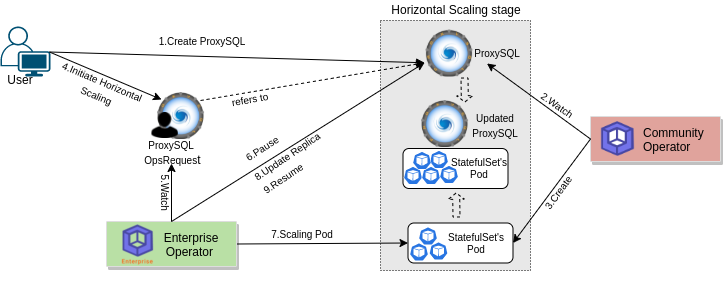You are looking at the documentation of a prior release. To read the documentation of the latest release, please
visit here.
New to KubeDB? Please start here.
ProxySQL Horizontal Scaling
This guide will give an overview on how KubeDB Ops Manager scales up or down ProxySQL Cluster.
Before You Begin
- You should be familiar with the following
KubeDBconcepts:
How Horizontal Scaling Process Works
The following diagram shows how KubeDB Ops Manager scales up or down ProxySQL components. Open the image in a new tab to see the enlarged version.

The Horizontal scaling process consists of the following steps:
At first, a user creates a
ProxySQLCustom Resource (CR).KubeDBCommunity operator watches theProxySQLCR.When the operator finds a
ProxySQLCR, it creates required number ofStatefulSetsand related necessary stuff like secrets, services, etc.Then, in order to scale the
ProxySQLthe user creates aProxySQLOpsRequestCR with desired information.KubeDBEnterprise operator watches theProxySQLOpsRequestCR.When it finds a
ProxySQLOpsRequestCR, it pauses theProxySQLobject which is referred from theProxySQLOpsRequest. So, theKubeDBCommunity operator doesn’t perform any operations on theProxySQLobject during the horizontal scaling process.Then the
KubeDBEnterprise operator will scale the related StatefulSet Pods to reach the expected number of replicas defined in theProxySQLOpsRequestCR.After the successfully scaling the replicas of the StatefulSet Pods, the
KubeDBEnterprise operator updates the number of replicas in theProxySQLobject to reflect the updated state.After the successful scaling of the
ProxySQLreplicas, theKubeDBEnterprise operator resumes theProxySQLobject so that theKubeDBCommunity operator resumes its usual operations.
In the next docs, we are going to show a step by step guide on horizontal scaling of ProxySQL database using ProxySQLOpsRequest CRD.



































